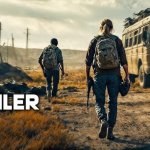𝙏𝙝𝙚 𝙆𝙚𝙚𝙥𝙞𝙣𝙜 𝙍𝙤𝙤𝙢 (𝟮𝟬𝟭𝟰)

The Keeping Room Official Trailer 1 (2015) – Brit Marling, Hailee Steinfeld Movie HD
The Keeping Room, directed by Daniel Barber, is a powerful blend of Western, thriller, and war drama set during the final days of the American Civil War. Starring Brit Marling, Hailee Steinfeld, and Muna Otaru, the film centers on three women struggling to survive and protect their home from Union soldiers in a remote part of the South. Exploring themes of survival, gender, and resilience, the film delves into how the horrors of war blur the lines between enemies and allies.
Plot Summary
As the Civil War draws to a close, Augusta (Brit Marling) lives in isolation on her family’s farm with her younger sister, Louise (Hailee Steinfeld), and their enslaved companion, Mad (Muna Otaru). With the men of the household gone, the women fend for themselves, attempting to keep their farm running amid the war’s devastation. Their daily life is interrupted when two renegade Union soldiers — Moses (Sam Worthington) and Henry (Kyle Soller) — on a path of destruction, stumble upon their isolated homestead.
Realizing the imminent threat, Augusta takes charge, preparing to protect her family against the soldiers’ assault. As the night unfolds, the three women are pushed to their limits, forced to confront their own fears and the soldiers in a brutal fight for survival.
Themes and Symbolism
The Keeping Room touches on themes of resilience, the breakdown of social norms, and the complexities of female solidarity during times of crisis:
- Female Empowerment and Resilience: The film portrays Augusta, Louise, and Mad as unlikely heroes, forced into roles of protectors. Their resilience highlights the strength of women during war, pushing beyond traditional gender roles as they stand against the threats they face alone.
- The Horrors of War and Isolation: The barren setting and scarce population symbolize the war-torn South, with the emptiness and silence reflecting the emotional toll the war has taken on those left behind. The characters’ isolation makes their ordeal more intense, emphasizing the vulnerability of women in a lawless, violent world.
- Survival and Morality: The film’s brutal depictions of violence blur the lines between right and wrong, as both the women and soldiers do what they must to survive. This moral ambiguity sheds light on the lengths people will go to in desperate situations, exploring how war strips people of their humanity.
Direction and Cinematography
Director Daniel Barber creates a tense, claustrophobic atmosphere, emphasizing the vulnerability of the women within their small, secluded home. The cinematography by Martin Ruhe captures both the beauty and desolation of the South, contrasting the peaceful isolation of the homestead with the violence that intrudes upon it. The shots linger on small details, building suspense as the tension escalates toward the final confrontation.
The slow, deliberate pacing allows the audience to feel the isolation and dread that hangs over the characters. Barber’s direction refuses to shy away from the brutality, instead presenting the violence in a raw and unfiltered manner that reflects the harsh reality of the time.
Sound and Score
The minimalistic score by Martin Phipps adds a haunting undercurrent to the film. Instead of a traditional score, the sounds of nature, silence, and subtle, unsettling tones create an atmosphere that enhances the tension and unease. The sound design amplifies every creak, footstep, and whisper, drawing viewers deeper into the characters’ emotional and psychological states.
Performances
The cast delivers raw, compelling performances that bring authenticity to the story. Brit Marling shines as Augusta, a strong-willed, determined woman who takes on a leadership role out of necessity. Marling’s portrayal conveys both strength and vulnerability, showcasing Augusta’s fear, courage, and desperation as she protects her family.
Hailee Steinfeld captures Louise’s youthful naivety, gradually revealing her character’s hidden courage. Muna Otaru, as Mad, delivers an especially nuanced performance, reflecting the complexities of her character’s past and the bond she shares with Augusta and Louise. Otaru’s portrayal adds emotional depth to the story, as her character confronts both her fears and her history.
Conclusion
The Keeping Room is a gritty, intense exploration of survival, female resilience, and the devastation of war. Its minimalist style and powerful performances make it a thought-provoking and haunting film that lingers long after it ends. By focusing on the plight of three women who must fight for their lives, The Keeping Room challenges traditional Western and war film narratives, offering a unique perspective on courage, solidarity, and the brutal reality of survival in times of chaos.











